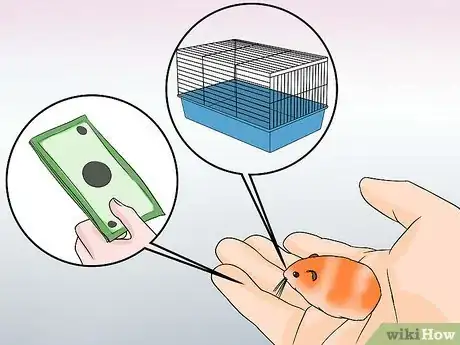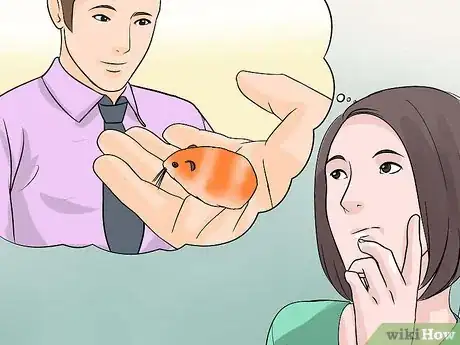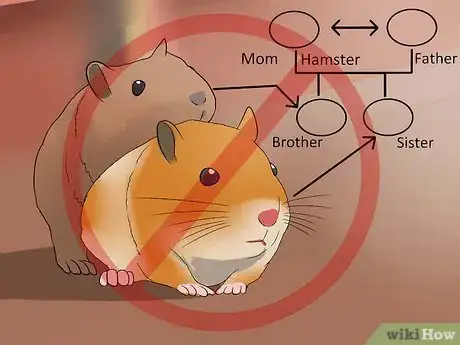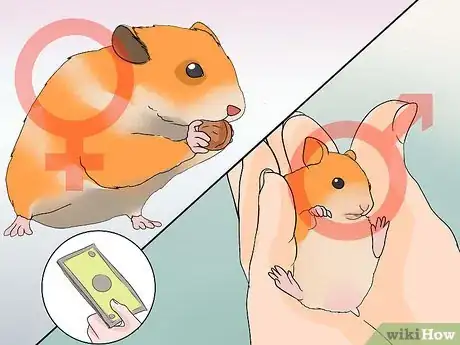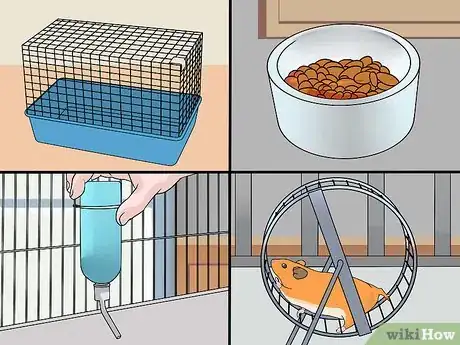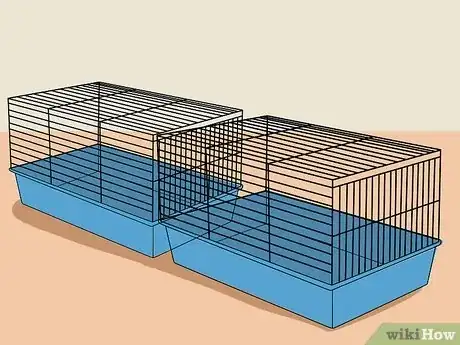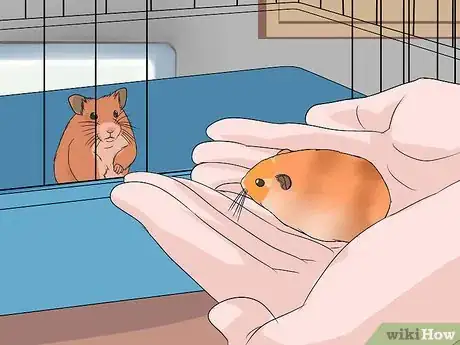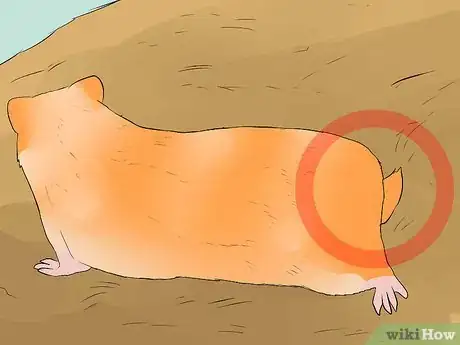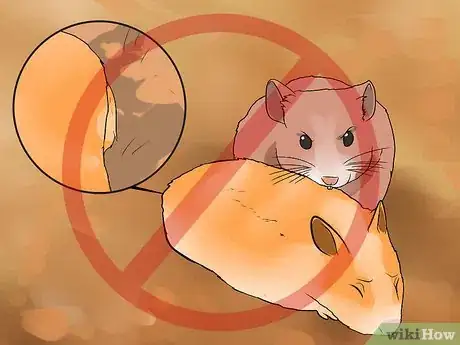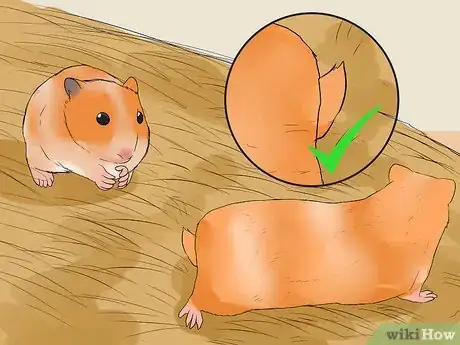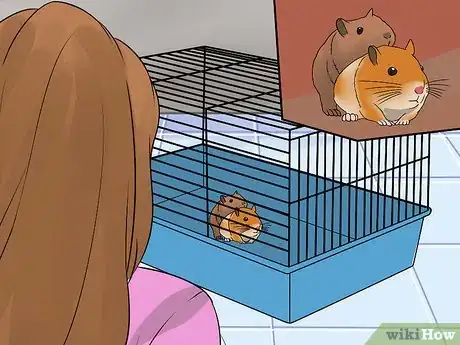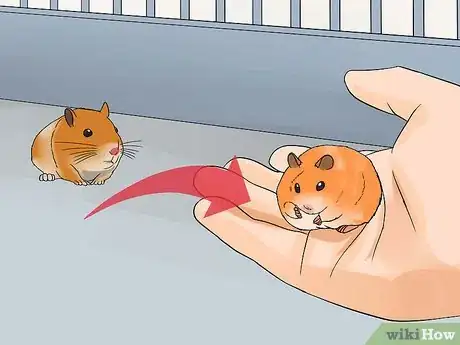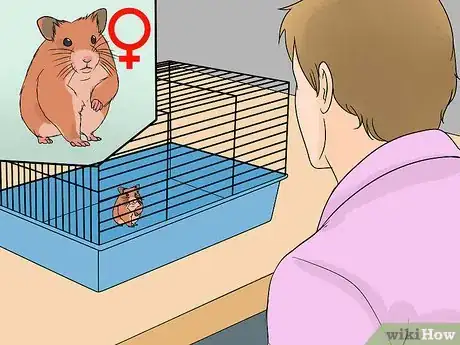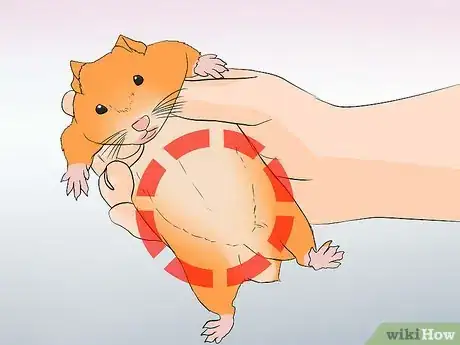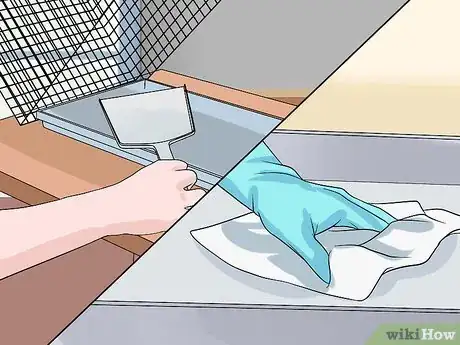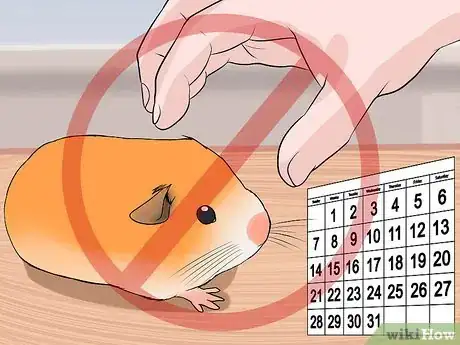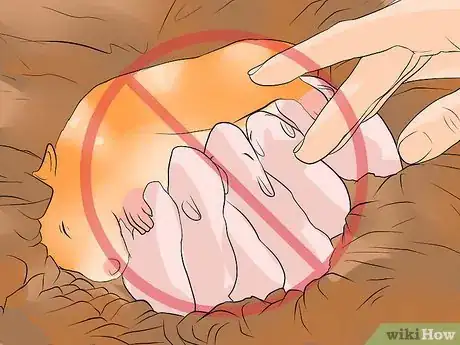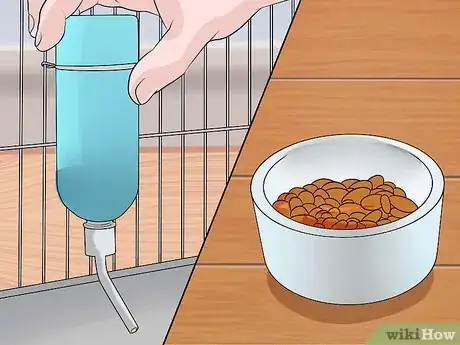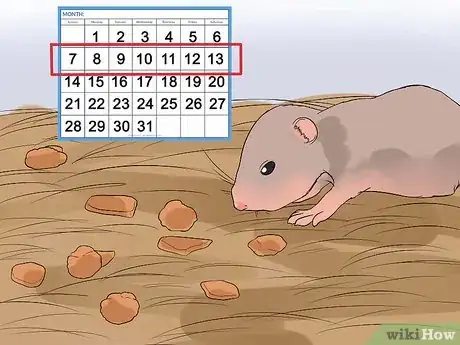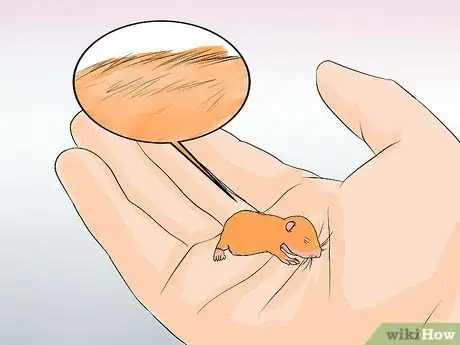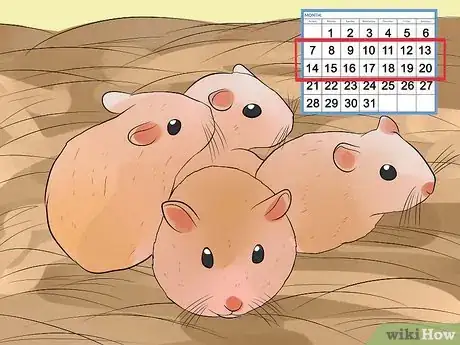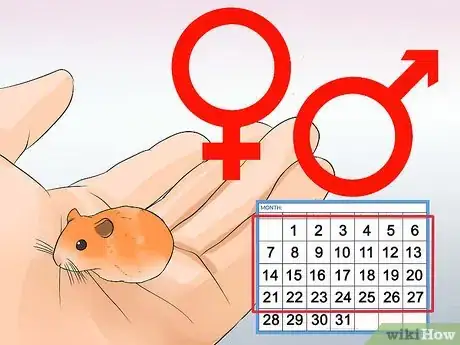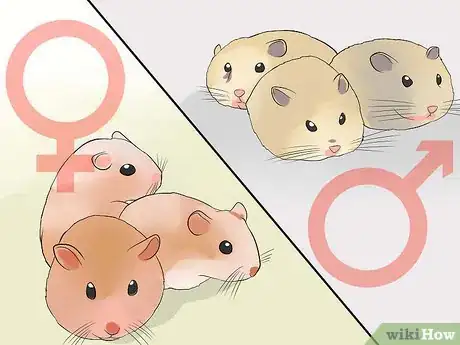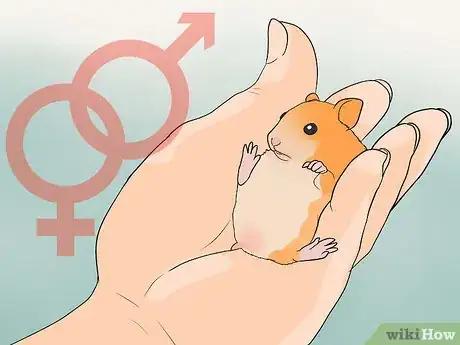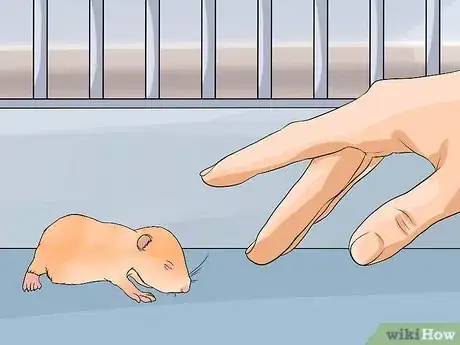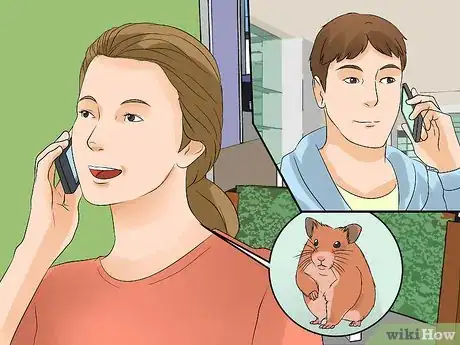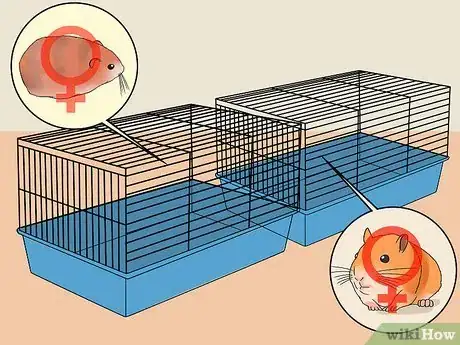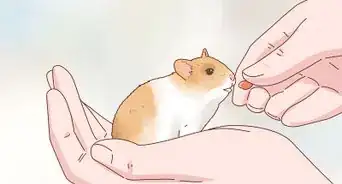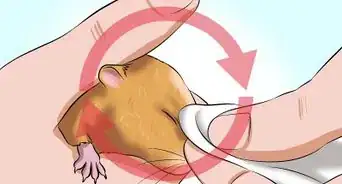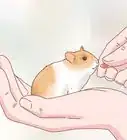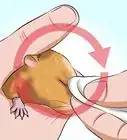This article was co-authored by Pippa Elliott, MRCVS. Dr. Elliott, BVMS, MRCVS is a veterinarian with over 30 years of experience in veterinary surgery and companion animal practice. She graduated from the University of Glasgow in 1987 with a degree in veterinary medicine and surgery. She has worked at the same animal clinic in her hometown for over 20 years.
This article has been viewed 248,871 times.
Are you considering breeding hamsters to add to your current hamster family? Plan ahead and educate yourself before adding more fuzzy friends to your household. Hamster breeding is not something to take lightly. Make a firm commitment to your plan before going through with it.
Steps
Preparing to Breed Syrian Hamsters
-
1Have a valid reason for breeding Syrian hamsters. You should have a clear plan in place about what you are going to do with all these babies. Also, ensure you have enough space, money, and resources to house them all yourself, in case your breeding plans do not go as planned. Some options include:
- Keeping them as pets.
- Selling them as pets (though it is unlikely to provide you with much income).
- Giving them away to good homes.
-
2Consider how you will execute your plan. You might think "I'll just give them away to good homes", but that is likely going to be harder than it sounds. Research the market before you begin breeding or you may end up with more hamsters than you have customers.
- How will you advertise your hamsters? Good places to start include online, in the newspaper classified ads, and at the pet store (be sure to ask permission first).
-
3Avoid breeding closely related hamsters. If you already own some hamsters from the same family, you do not want to breed them with each other. When you allow brothers to mate with sisters, or fathers/daughters or mothers/sons, you create an inbred line of hamsters. Inbred lines can suffer from genetic flaws. For healthy hamsters, avoid inbreeding altogether.
-
4Purchase an unrelated male and female hamster. If the hamsters you have are all related, or if you do not yet have any, talk to several hamster breeders about where they get their stock. You only need one male and one female to get started. It is best to purchase them from different suppliers, to ensure the two breeding animals are not closely related.
- It is can be a poor idea to buy breeding hamsters from chain pet stores. Some pet stores can treat their hamsters quite poorly. Many get their hamsters that have been bred in dirty and cramped locations.
- Baby hamsters, if chosen from a commercial pet store, are likely to suffer from mental, physical and even fatal deformities. Also, the hamster very often have poor temperament, and have a poor coloring.
- You might also contact a hamster breeder directly.[1]
-
5Make sure that the hamsters are about the same age. Hamsters can start breeding as early as two months of age. However, it is best to let them grow to four to six months of age before beginning the breeding process. This improves the chances of a healthy litter.
-
6Provide the hamsters with a comfortable environment. This means cages of a good size that are at the very least 450 sq. inches or larger. Since many commercial cages are too small, you may have to a do-it-yourself project ahead of you. Careful planning is important if you plan to breed, as each hamster should have its own cage. Keep the hamsters in their separate cages, unless you are actively trying to breed them. When you first get the hamsters, keep the cages in the same room, but not close together. Each one should contain:
- A food bowl with high-quality food (One of the best hamster foods by far is the Harry/Hazel Hamster mix.)
- An inverted water bottle
- Exercise toys
- Anything else you think will make them feel more at home
-
7Move the cages together after a week. This will allow your male and female to see and smell each other. Let them become more social, but do not put them together in one cage yet.
- Another way to let them get acquainted is to put them into separate exercise balls. While you are watching, let them roll around in their pods, smelling each other and interacting safely.
-
8Introduce the hamsters when they come of age. Once your hamsters are at least four months old, you can introduce them to each other in a third, neutral cage. If the female attacks the male, she is not ready to mate. Get him out of the cage as soon as possible, to avoid injury.
Mating Your Hamsters
-
1Determine whether the female is in heat. You cannot mate your hamsters if the female is not going to be receptive to the male. At this age, she could go into heat every four to five days.
- Gently stroke the female on the bottom. If her tail goes erect, she is in heat and ready to mate with the male.
-
2Only place the hamsters together when the female is in heat. Hamsters are territorial animals. If they do not want to mate, they will likely ending up fighting, leading to injury, or even death. Check the female every day until she is in heat before placing them together.
-
3Place the hamsters in the same cage when the female is in heat. Either gently place her in the male's cage or put both hamsters in a neutral third cage. Do not place the male in the female's cage, however, as she will likely fight him to protect her territory.
-
4Supervise the mating process. If all goes well, the female's tail should go erect, and the male should mount her more than once. This may last for around 30 minutes, and the male will likely clean himself between attempts.[2]
- Be watchful for fights, even if the female seems receptive.
-
5Separate them when they are finished. You will be able to tell when they are finished because they will suddenly seem disinterested in each other. When this happens, move the female back into her cage.
-
6Make a record of the date. An important part of breeding hamsters is keeping good records. Either mark mating dates on a calendar or write them down in a notebook.
- Hamsters hibernate when the temperature dips below 50°F (10°C). They will not breed at that temperature.[3]
Preparing for Birth
-
1Observe the female for a week. Sometimes, a hamster's behavior changes noticeably when she gets pregnant. Note if she is being strangely quiet, cleaning herself more often, or eating and drinking more than usual. Another common sign is an instinct to gather up large nests. If you see these telltale behavior changes, she is likely pregnant.
-
2Figure out when she will give birth. Syrian hamsters usually grow and carry their babies for 15-18 days before giving birth. Look up the date on which you last mated your hamsters and add 15 days to it. That is the earliest likely due date for your new litter.
-
3Watch for physical changes in the female. You will not be able to tell she is pregnant until just a few days before she gives birth. By ten days after the mating, you should be able to see her belly clearly swelling, as with human pregnancies.
-
4Provide her with nesting and bedding materials. A pregnant female will have a natural instinct to build herself a big nest. Give her extra bedding materials like paper towels or bathroom tissues so she can shred them up for her nest.
- You might also offer a safe (non toxic, no ink, not sharp) bedding material like Pennine “Curl Up” Hamster bedding.[4]
-
5Prepare the cage for the birth and babies. Make sure you have cleaned the cage five days or so before the due date, and that there is extra food and bedding in the cage. Prepare ahead of time so you do not disturb the mother and babies for the first week after birth.
-
6Do not handle the hamster close to her due date. You want to keep her as calm and relaxed as possible. Keep her environment quiet and soothing; dim or remove bright lights. Keep curious pets like dogs and cats away from her as she gets ready to deliver her babies.
- Hamsters usually give birth without problems if you wait until they are old enough to mate (four months).
- The birth will likely happen at night when everything is quiet.
- Litters can be as small as 4 or as large as 16 babies.[5]
Taking Care of the New Litter
-
1Do not disturb the new mother or her babies. Female hamsters sometimes eat their own babies if they get stressed out. It is very important to keep the environment as calm as possible. Though you might be eager to play with the babies, give the mother space and peace for their safety.
- At first, the babies will look pink and hairless. They are born with their eyes closed.
-
2Continue to care for her after the delivery. While you do not want to disturb her, you do still need to make sure she has everything she needs in her cage. For the first week and a half to two weeks or so, discretely refill the mother's food bowl and water bottle.
- You do not need to provide the babies with anything at this point. They will get everything they need from nursing.
-
3Begin feeding the babies about one week after birth. Scatter small portions of broccoli, grated carrot, wheat germ, or tofu in their nest for them to eat.[6] The mother will also store food in her cheek pouches, and bring it back to the nest to feed her babies.
-
4Check for healthy development in the babies. A week after birth, they will start to grow fur. You should just be able to tell what colors they are. The "pups" will also start making little noises at this age. One or two adventurous babies may leave the nest, but do not worry if the mother picks them up in her mouth and puts them back.
-
5Clean the cage at two weeks. Enough time should have passed now to allow the mother settle into her new role, so you can give the cage a much-needed cleaning. It is also your first opportunity to handle the babies, which is an important step in socializing them to humans. By handling them at two weeks, you make them more comfortable with human interactions.
- Get your hands "dirty" with the scent of the used litter before touching the babies. This prevents the mother from rejecting or attacking them later.[7]
- Move the hamsters into another cage one by one.
- When cleaning the cage, avoid completely destroying the nest.
- Hamsters will usually have a “toilet” area in the cage. Concentrate your cleaning there, and leave the nest more or less intact.
- If the nest is soaked or filthy, however, go ahead and replace it with fresh materials.
-
6Adjust the cage for the babies. While cleaning the cage, make a few changes to transition them into adulthood. Add a second food bowl to the cage. The mother's water bottle will be too high for the babies, so place a second one at a lower position. You could also place a raised platform under the mother's bottle so the babies can reach it.
- Do not lower the mother's water bottle to the babies' height because then the mother will not be able to reach it.
-
7Check the babies’ two-week development. At this age, the babies should have all their fur and be running about independently. Though they were born with closed eyes and ears, they should be starting to open up now.
-
8Determine the babies' genders at around three and a half to four weeks. This can be a tricky process. Look at the distance between each hamster's anus and genital opening. The distance on a male will be longer than the distance on a female.[8] By four weeks, the males' testicles should also be noticeable, as should the nipples on the females' bellies.
-
9Separate the males and females once you determine the genders. Hamsters have a lot of loose skin, and you can hold them by the scruff of their necks or by the loose skin down their backs. Be careful not to drop them, and be ready to return them to the cage, if you start to lose your grip.
-
10Double check the babies' genders. Not all hamsters mature at the same rate, so you have to make sure you gendered them correctly. For a few days after you separate them into male and female cages, keep checking gender every day. You might notice testicles one day that you did not see before in a cage of baby “females.” If so, switch the baby to the correct cage.
- If you are unsure about the sex of your babies, take them to your vet or an experienced hamster breeder for help. You want to avoid accidental breeding of siblings.
-
11Get the babies used to human handling. Place your hand in the cage so they can smell it, and let them climb up into your palm if they want to. You can also scoop them up with a small cup and start gently petting them on the back.
- The babies will be ready for their new homes 35 days their birth.[9]
-
12Line up customers early. Do not wait too long to start looking for people to purchase your hamsters, because the 35 days goes by fast. Keep your customers updated as the hamsters approach 35 days old, so they can prepare their own homes.
-
13Sell the hamsters. Make sure you send them off to reliable homes, with families that will love them. Provide the new owners with information on hamsters and the hamster's care to this point. You want the babies to have the best new start you can provide.
-
14Separate hamsters after two to three months of age. If you keep any of the babies, know that Syrians are highly territorial. When they reach two to three months of age, separate all hamsters into their own cages.
Expert Q&A
Did you know you can get expert answers for this article?
Unlock expert answers by supporting wikiHow
-
QuestionIs it okay for a hamster to chew its cage?
 Pippa Elliott, MRCVSDr. Elliott, BVMS, MRCVS is a veterinarian with over 30 years of experience in veterinary surgery and companion animal practice. She graduated from the University of Glasgow in 1987 with a degree in veterinary medicine and surgery. She has worked at the same animal clinic in her hometown for over 20 years.
Pippa Elliott, MRCVSDr. Elliott, BVMS, MRCVS is a veterinarian with over 30 years of experience in veterinary surgery and companion animal practice. She graduated from the University of Glasgow in 1987 with a degree in veterinary medicine and surgery. She has worked at the same animal clinic in her hometown for over 20 years.
Veterinarian It is not ideal that the hamster chews its cage, but the materials from which modern cages are made make it unlikely the hamster will come to harm. There's a possibility chewing on metal may blunt or damage the hamster's teeth in the long term. Likewise, be vigilant with a plastic cage, that the hamster doesn't chew of chunks that are then swallowed. Try providing plenty of natural wood chews to divert the chewing activity onto something more appropriate.
It is not ideal that the hamster chews its cage, but the materials from which modern cages are made make it unlikely the hamster will come to harm. There's a possibility chewing on metal may blunt or damage the hamster's teeth in the long term. Likewise, be vigilant with a plastic cage, that the hamster doesn't chew of chunks that are then swallowed. Try providing plenty of natural wood chews to divert the chewing activity onto something more appropriate. -
QuestionCan the father be around the babies?
 Pippa Elliott, MRCVSDr. Elliott, BVMS, MRCVS is a veterinarian with over 30 years of experience in veterinary surgery and companion animal practice. She graduated from the University of Glasgow in 1987 with a degree in veterinary medicine and surgery. She has worked at the same animal clinic in her hometown for over 20 years.
Pippa Elliott, MRCVSDr. Elliott, BVMS, MRCVS is a veterinarian with over 30 years of experience in veterinary surgery and companion animal practice. She graduated from the University of Glasgow in 1987 with a degree in veterinary medicine and surgery. She has worked at the same animal clinic in her hometown for over 20 years.
Veterinarian No, it's best to remove him. Not only might his presence stress the mother, which could lead her to reject the babies, but there is a risk of him cannibalizing (eating) the babies. Another consequence of not removing the father is that the mother could fall pregnant again very quickly, which is not healthy for her.
No, it's best to remove him. Not only might his presence stress the mother, which could lead her to reject the babies, but there is a risk of him cannibalizing (eating) the babies. Another consequence of not removing the father is that the mother could fall pregnant again very quickly, which is not healthy for her. -
QuestionHow can I clean the cage without disturbing the mother and babies?
 Pippa Elliott, MRCVSDr. Elliott, BVMS, MRCVS is a veterinarian with over 30 years of experience in veterinary surgery and companion animal practice. She graduated from the University of Glasgow in 1987 with a degree in veterinary medicine and surgery. She has worked at the same animal clinic in her hometown for over 20 years.
Pippa Elliott, MRCVSDr. Elliott, BVMS, MRCVS is a veterinarian with over 30 years of experience in veterinary surgery and companion animal practice. She graduated from the University of Glasgow in 1987 with a degree in veterinary medicine and surgery. She has worked at the same animal clinic in her hometown for over 20 years.
Veterinarian Wait until the babies are at least 2 weeks old. As suggested in the article, get the smell of the soiled bedding on your hands so your scent is less of a threat. Rather than remove the mother and babies from the cage, scoop out areas of bedding and do a spot-clean, replacing soiled bedding with fresh and wiping things down as best you can.
Wait until the babies are at least 2 weeks old. As suggested in the article, get the smell of the soiled bedding on your hands so your scent is less of a threat. Rather than remove the mother and babies from the cage, scoop out areas of bedding and do a spot-clean, replacing soiled bedding with fresh and wiping things down as best you can.
Warnings
- Despite what pet shops say, an 80 x 50 centimeters hamster cage is the smallest acceptable size for a hamster cage. Make sure that the babies cannot escape, as they are much smaller than the adult hamsters. Using a cage with clear solid sides (like a fish tank) will prevent the babies from escaping or getting caught in wire floored cages⧼thumbs_response⧽
- Breed healthy animals with good temperaments. This increases the likelihood that the babies will also have good health and temperament.⧼thumbs_response⧽
- Line up customers before breeding the hamsters.⧼thumbs_response⧽
- When the babies are born, do not touch them. The mother could abandon or even cannibalize her own babies.⧼thumbs_response⧽
- Avoid loud noises, bright lights and commotion.⧼thumbs_response⧽
- Have the information for a hamster-savvy vet who can answer your questions along the way. Develop a relationship with him or her before you start breeding hamsters.⧼thumbs_response⧽
- Do not allow anybody to buy a hamster if the cage they intend to put him or her in is smaller than 80 x 50 centimeters, or they seem unprepared for caring for a hamster.⧼thumbs_response⧽
- Mother hamsters can have up to 20 babies or more, so make sure that you have enough bedding, food and space in the cage.⧼thumbs_response⧽
Things You'll Need
- Cages
- Lots of hamster food (depending on how many babies).
- Lots of bedding during the end of gestation, so she can prepare the nest, and do her best before delivering the babies.
References
- ↑ http://www.hamstercentral.com/community/hamster-shows/
- ↑ http://hamsters-uk.org/ (The National Hamster Council)
- ↑ Seiji Ueda, Nobuo Ibuka, An analysis of factors that induce hibernation in Syrian hamsters, Physiology & Behavior, Volume 58, Issue 4, October 1995, Pages 653-657, ISSN 0031-9384
- ↑ http://hamsters-uk.org/ (The National Hamster Council
- ↑ Marie Odile Monier Chelini, Rupert Palme, Emma Otta, Social stress and reproductive success in the female Syrian hamster: Endocrine and behavioral correlates, Physiology & Behavior, Volume 104, Issue 5, 24 October 2011, Pages 948-954.
- ↑ http://hamsters-uk.org/ (The National Hamster Council)
- ↑ http://hamsters-uk.org/ (The National Hamster Council)
- ↑ http://hamsters-uk.org/ (The National Hamster Council)
- ↑ http://www.hamstercentral.com
About This Article
To breed Syrian hamsters, start by getting an unrelated male and female hamster and keeping them in separate cages. After about a week, move the cages next to each other so the hamsters start to get acquainted. Once your female hamster is in heat, move both hamsters into a third, neutral cage together. Keep a close eye on them to make sure the male mounts the female and they don't start fighting. When they're finished mating, move your hamsters back into their own cages. To learn how to prepare for your female hamster giving birth, scroll down!
